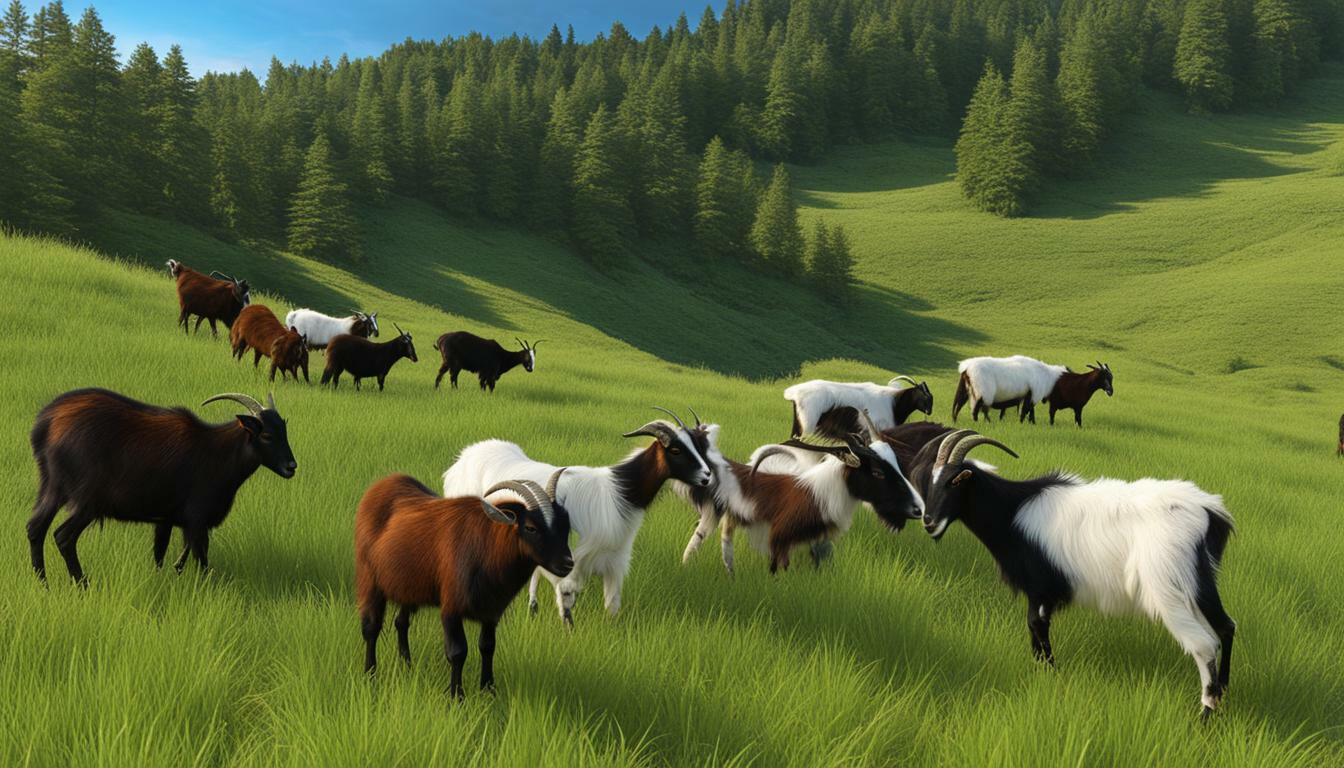Goats are fascinating creatures, and they can be found in a variety of environments. Some goats are raised on farms, while others live in the wild. You might think that all goats are the same, but there are actually many differences between farm goats and wild goats. In this article, we will explore the unique characteristics of each type of goat.
Key Takeaways
- Farm goats and wild goats have distinct physical and behavioral differences.
- Farm goats have been domesticated, while wild goats live in their natural habitats.
- The diet, reproduction, and breeding of farm goats and wild goats vary greatly.
Domestication and Living Environment
Farm goats have been domesticated for thousands of years, and as a result, they have adapted to living alongside humans. They are typically kept on farms, where they have access to food, water, and shelter. Farm goats are also used for their milk, meat, and fiber, which makes them an important part of agricultural communities.
Wild goats, on the other hand, live in a variety of natural habitats, including mountains, deserts, and grasslands. They have not been domesticated, and they generally avoid human settlements. Wild goats are well-adapted to living in the wild, and they are able to find their own food and water sources.
Due to their domestication, farm goats have become dependent on human care and are unable to survive on their own in the wild. They are usually kept in fenced pastures or barns to protect them from predators and other dangers.
Physical Characteristics
The differences between farm goats and wild goats are not just limited to their living environments – they also have distinct physical characteristics. Farm goats are typically smaller in size and have thinner, softer coats compared to their wild counterparts. They may also have a wider range of coat colors due to selective breeding.
Wild goats have adapted to their natural environments by growing thicker coats to keep warm in colder climates. They are generally larger in size, with longer horns and more muscular bodies. Their dominant coat color is typically brown or grey, helping them blend into their surroundings.
Overall, the physical differences between farm goats and wild goats are a result of their selective breeding and adaptations to different living environments.
Physical Characteristics
One of the most noticeable differences between farm goats and wild goats is their physical appearance. Farm goats have been selectively bred over generations to produce various strains that are typically larger and have a more uniform size and color. They are often cream, white, or black and have short, shiny fur. Their horns tend to be less prominent, straighter, and smoother than those of wild goats.
Wild goats, on the other hand, have more irregular physical characteristics that have developed over time in response to their natural environment. They are generally smaller than farm goats and have a shaggier, thicker coat that provides insulation in cold weather. Their horns tend to be longer and more curved, which serves as a defensive mechanism against predators.
Another notable difference between farm goats and wild goats is their behavior and temperament. Farm goats are generally more docile and easy to handle, while wild goats are often more skittish and untamed. This difference in behavior is partly due to their respective living environments, as domestication has allowed farm goats to become more accustomed to human interaction, while wild goats have retained their natural instincts.
Behavior and Social Structure
Farm goats and wild goats differ significantly in their behavior and social structure.
Wild goats are highly adaptable and can thrive in various terrains and climates. They usually live in herds, with males and females staying together, and establish dominance through headbutting and horn clashing. They are also known to use scent marking to communicate with each other and establish their territories. Wild goats are primarily browsers, meaning they feed on a variety of vegetation, including leaves, twigs, and shrubs.
On the other hand, farm goats are more docile and socialize easily with humans and other animals. They usually live in small herds and establish dominance through bullying or submission. Farm goats are primarily grazers, meaning they feed on grass and hay. They have also been observed to have distinct behavior patterns, such as tail wagging and vocalization, which are a result of selective breeding.
The social structure of farm goats has been significantly influenced by domestication and human intervention. They have been selectively bred to exhibit specific desirable traits, such as docility and large milk production. This has led to a genetic divergence from their wild counterparts and changes in their behavior patterns.
Diet and Feeding Habits
When it comes to diet, farm goats and their wild counterparts have significant differences in their feeding habits. Wild goats are foragers and prefer browsing on leaves, bark, and shrubs. They are known to climb mountains and cliffs in search of their preferred food sources. On the other hand, farm goats have been domesticated to eat a wider range of food and are usually fed on grains and hay.
Farm goats have adapted to human intervention in their feeding habits and can eat a more varied diet, including commercial feeds and supplements. Their feeding habits are influenced by factors such as their living environment, age, and gender. For instance, lactating goats require a higher protein diet, while kids need to be fed with a smaller, more frequent meal.
Wild goats have a more varied diet and can survive in harsh environments where there is little vegetation. They have a unique way of feeding that allows them to extract nutrients from plants that are unpalatable to other herbivores. Their natural ability to forage makes them resilient to natural disasters such as drought and wildfires.
In farm settings, goats are often provided with water and food in troughs, while wild goats have to rely on natural water sources such as streams and rivers. This means that wild goats have to travel longer distances to find water and are adapted to survive longer periods without drinking water than their domesticated counterparts.
The diet and feeding habits of goats have significant impacts on their health, growth, and productivity. Farmers and herders need to pay close attention to the nutritional requirements of their goats to ensure their well-being and maximum production.
Examples of wild and farm goat diets:
| Type of Goat | Preferred Diet |
|---|---|
| Wild Goats | Leaves, bark, shrubs, grasses, and lichen |
| Farm Goats | Hay, grains, commercial feeds, and supplements |
In conclusion, the diet and feeding habits of farm goats and wild goats vary significantly. Wild goats are adapted to surviving harsh environments and have a more varied diet, while farm goats have been domesticated to eat a wider range of food. It is vital for farmers and herders to provide their goats with a balanced diet that meets their nutritional requirements.
Reproduction and Breeding
Farm goats and wild goats have distinct differences in terms of their reproduction and breeding. Domestication has played a significant role in altering the breeding cycles, gestation periods, and survival rates of farm goats. In contrast, wild goats have maintained their natural breeding patterns.
Wild goats have a seasonal breeding cycle, with mating typically occurring in the fall and winter months. The gestation period for wild goats is approximately 150 days, after which the female gives birth to one or two offspring. Wild goat kids are born with the ability to walk and follow their mother immediately after birth.
In contrast, farm goats have been selectively bred to have year-round breeding cycles. Female farm goats can produce offspring multiple times a year, while the gestation period is usually around 150 days. However, selective breeding has also reduced the survival rates of offspring, as they are more susceptible to diseases and other health issues.
When it comes to breeding, wild goats generally mate with multiple partners, while farm goats are often selected for specific breeding characteristics. This has resulted in a greater degree of genetic variation among wild goats compared to farm goats, which tend to have more uniform characteristics.
Overall, the distinct differences in reproduction and breeding between farm goats and wild goats highlight the significant impact that domestication and selective breeding have had on these animals.
Conclusion
In conclusion, it is clear that there are significant differences between farm goats and their wild counterparts. Domestication has played an important role in shaping the physical characteristics, behavior, and reproductive patterns of farm goats. These domesticated goats are typically bred for specific purposes, such as meat or milk production, and they are adapted to living in close proximity to humans.
On the other hand, wild goats have evolved to survive in natural environments, and they are better equipped to handle the challenges of living in the wild. Their physical characteristics, behavior, and dietary preferences reflect their natural habitat and the need to adapt to changing conditions.
While the distinctions between farm goats and wild goats are significant, both types of goats play important roles in our ecosystem. It is important to appreciate and understand these differences in order to promote the well-being of these animals and make informed decisions about their care.
Overall, farm goats and wild goats are fascinating animals with unique and interesting characteristics. Whether you are a farmer, a nature enthusiast, or simply curious about these creatures, there is much to learn and appreciate about both types of goats.
FAQ
Q: What sets farm goats apart from wild goats?
A: Farm goats and wild goats have distinct differences in their living environment, physical characteristics, behavior, diet, and reproduction.
Q: How have farm goats been domesticated?
A: Farm goats have been selectively bred and raised in captivity for generations, resulting in their adaptation to human-controlled living environments.
Q: What is the natural habitat of wild goats?
A: Wild goats can be found in various landscapes, including mountains, cliffs, and rocky terrains. They are adapted to survive in rugged and challenging environments.
Q: What are some physical characteristics that differentiate farm goats from wild goats?
A: Farm goats are generally smaller in size, have a wider range of coat colors, and may have horns that vary in shape compared to wild goats.
Q: How do farm goats and wild goats differ in behavior and social structure?
A: Farm goats typically exhibit more social and docile behavior due to domestication, while wild goats have a more hierarchical social structure and rely on different communication methods.
Q: What do farm goats and wild goats prefer to eat?
A: Farm goats are often fed a controlled diet by humans, while wild goats depend on foraging for natural food sources such as grass, leaves, and tree bark.
Q: How does the reproduction of farm goats differ from wild goats?
A: Farm goats have been selectively bred to exhibit specific reproductive traits, and their breeding cycles, gestation periods, and offspring survival rates can differ from those of wild goats.



